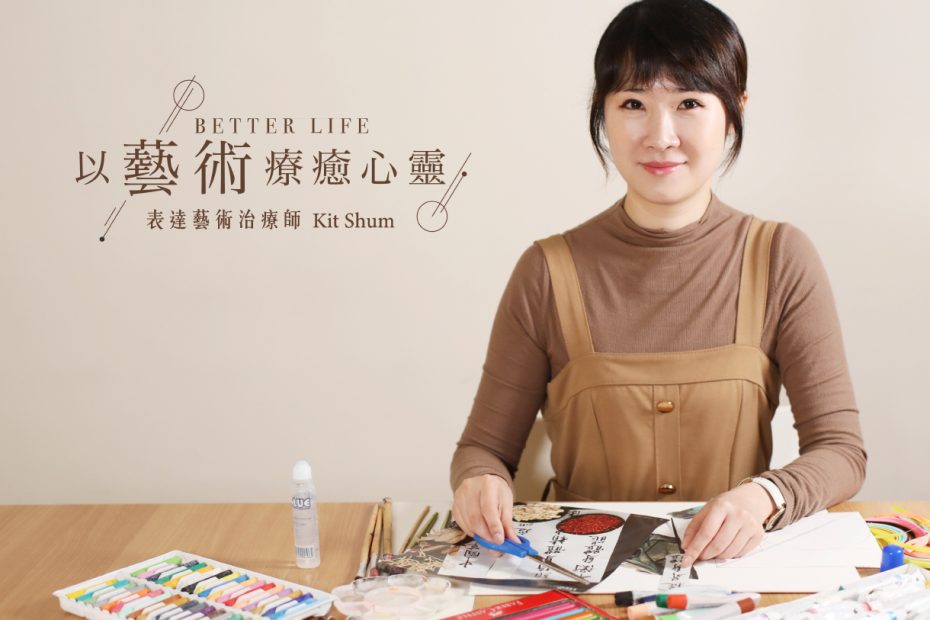Visiting art galleries to see exhibitions, going to watch different stage performances, is no longer just a weekend activity exclusive to hipsters. Urbanites all crave to find some balance and tranquility in their inner selves through art displays and performances. Art indeed has a healing effect on the soul, but true artistic psychological healing does not come from interpreting others’ creations, but from returning to oneself, starting from the heart to understand oneself in different artistic ways, discovering more aspects of oneself!
Many people have misunderstandings about art therapy, thinking that satisfaction from viewing exhibitions or performances is healing, and believing that “me time” from different artistic creations such as painting, dancing, or singing is healing. Art therapy practitioner Kit Shum tells everyone that true art therapy is about expressing one’s inner self.

// Understand yourself through the details of creation //
A person’s personality formation, attitudes towards different things, are mostly related to their growth and past experiences. Obsessive-compulsive disorder, anxiety disorder, seemingly common behaviors and mental issues among urbanites, are often caused by the strict demands of parents during growth or excessive worries, which many people are unaware of. When you express yourself through different forms of art, art therapists will observe your small actions and behavioral patterns, even if it’s a sudden dance move or the use of paint in a painting, which can reveal your personality. Expressing, exploring during the creative process, understanding your hidden self, understanding the hidden causes of your unhappiness in life, is the biggest difference between art therapy, art appreciation, and art creation.


// Van Gogh also needs art therapy //
You may ask, isn’t the artistic process inherently healing and quite personal, why is the intervention of an art therapist needed in the process of creation and expression? Kit Shum uses the example of the art master Van Gogh, “If art is simply healing, then why do actors suffer from depression? Why would art masters like Van Gogh suffer from mental illness? It’s because they release too many negative emotions during the creative process without being aware of it or knowing how to deal with it. This is when they need the help of a psychologist or therapist to guide them to understand the causes of emotional issues, assist them, and accompany them in transforming negative emotions into positive ones. Expressive art therapy is actually a combination of psychology and art, expressing oneself through artistic creation, understanding, settling, and reflecting.”


// Art therapy knows no distinction between beauty and ugliness //
Artistic expression has no threshold. Even if you don’t understand painting techniques, can’t play a musical instrument, or lack a sense of rhythm and have a stiff body, you can still express yourself through art. “We will not criticize or describe anyone for lacking aesthetic sense or artistic cells. Looking back at everyone’s infancy, infants express themselves by hitting toys and drawing on paper. The so-called standards of beauty and ugliness are all derived from education and learning, and these standards often make people feel frustrated,” Kit pointed out that beauty and ugliness are definitions of the adult world. The creative process is more important than the finished product, and everyone should learn to appreciate their own creations instead of constantly criticizing them based on external standards. Without understanding and appreciating oneself, one cannot step out to understand oneself, accept oneself, and break through oneself. “Art has no distinction between beauty and ugliness, it is just a form. Whether singing, dancing, or even collaging with leaves, as long as you enjoy the process, it is the art of life.” Different forms of expression actually lead to the same goal. The most important thing is to return to one’s inner self, let go of criticism, reflect on one’s own situation, and after reflection, both one’s own attitude and how one treats others can change. Embrace a more diverse life through acceptance and transformation.

後記:
你畫畫時,喜歡一點一線的規律感?不喜歡顏料桌雜亂無章嗎?創作中給予自己過多規範,對自己要求極高,令自己經常處於緊張狀態,以為受影響只有自己?你的高要求與焦慮其實也影響身邊人,放下「一定」及「必要」,接受另一種思維及態度,把自己帶回中庸平衡的位置,生活其實能過得更輕鬆更自在。
—
Producer: Vicky Wai
Editor: Candy Chan
Videographer: Andy Lee, @man_tam_
Photographer: @man_tam_
Video Editor: Andy Lee
Designer: Tanna Cheng
Special Thanks: @kitshumartstherapist

